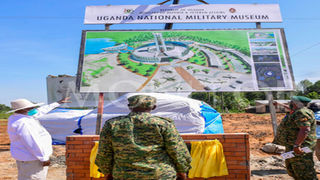
President Museveni (left) after laying a foundation stone for Uganda National Military Museum near River Katonga Bridge, Mpigi District, on December 29, 2020. PHOTO/FILE
|National
Prime
Military museum works stall
What you need to know:
- A military source says works stalled when Lt Gen Pecos Kutesa, who had been tapped to chair its steering committee, died.
The planned construction of a national military museum near River Katonga Bridge on Masaka–Kampala highway is yet to commence a year after President Museveni flagged off the project.
On December 29, 2020, the President, who is also the Commander-in-Chief of armed forces, laid a foundation stone for the project. The construction, which was expected to take four years, is estimated to cost Shs110b.
However, almost 14 months on, no actual construction has started. The museum is intended to preserve and conserve the history of Uganda military.
A military source, speaking on condition of anonymity, said the project failed when Lt Gen Pecos Kutesa, who had been tapped to chair its steering committee, died in India on August 17, 2021.
He had headed the army’s doctrine and represented the institution in Parliament, but his frustrations grew with time, leading him to publish a critical and revealing book titled, Uganda’s Revolution 1979-1986: How I Saw It.
Lt Col Ronald Kakurungu, the UPDF deputy spokesperson, admitted that Kutesa’s death partly affected the project’s progress, but he said everything has now been rebooted after Maj Gen Henry Masiko, the UPDF chief political commissar, was named successor.
The land for the museum, he said, had been secured and late Kutesa’s committee had already done inventory on items to be placed in the museum.
Kutesa selected Katonga as the site for the National Military Museum to immortalise as a defining spot, where National Resistance Army (NRA) rebels, fought a bloody war to achieve victory.
“The museum is not only about physical structures, but bringing out the right picture of the 1986 liberation struggle, the very reason why the steering committee is composed of 10 members, five of them are historians while others are senior military offices with right background information about the liberation struggle,” Lt Col Kakurungu said at the weekend.
He added that Mr Museveni has directed Maj Gen Masiko’s committee to document the unique and special history of the NRA’s five-year guerrilla war.
“The steering committee is now concentrating on analysing information gathered from military offices, and civilians who were part of the bush war, and after all this actual construction will start,” he said.
Background
In September 1985, Katonga Bridge was a battlefield between Uganda National Liberation Army (UNLA) soldiers and NRA fighters as the latter attempted to cross to Kampala from Masaka direction. Fighting at the bridge lasted four months and is recorded in Uganda’s military history as one of the bloodiest battles.
After gaining control of the bridge, it made the NRA’s eventual assault on Kampala much easier. Even during the 1979 liberation war that toppled former President Idi Amin, scores of Libyan soldiers who were fighting alongside the Uganda army, the then national army, were killed at the same bridge. The killing of the Libyan soldiers was a big blow, consequently leading to Amin’s downfall.
To remember the fallen Libyan soldiers, government erected a huge billboard bearing photos of both President Museveni and slain Libyan leader Muammar Gaddafi. While breaking the ground of the national military museum in December 2020, President Museveni directed the UPDF to add the portraits of the former Tanzanian leader Julius Nyerere and Samora Machel of Mozambique to recognise their contribution to Uganda’s liberation struggle from the early 1970s.




